RIGHT TURN ONLY!!
Mage in the Shell
by Carlo Santos,

This is a sad, sad world we live in where the New York Yankees are World Series champions... again.
But it could've been worse. It could have been the Dodgers.
THE GHOST IN THE SHELL
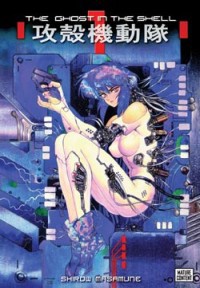
(by Shirow Masamune, Kodansha Comics, $26.99)
FROM THE BACK COVER:
"Deep into the twenty-first century, the line between man and machine has been inexorably blurred as humans rely on the enhancement of mechanical implants and robots are upgraded with human tissue. In this rapidly converging landscape, cyborg superagent Major Motoko Kusanagi is charged to track down the craftiest and most dangerous terrorists and cybercriminals, including 'ghost hackers' who are capable of exploiting the human/machine interface and reprogramming humans to become puppets to carry out the hackers' criminal ends. When Major Kusanagi tracks the cybertrail of one such master hacker, the Puppeteer, her quest leads her into a world beyond information and technology where the very nature of consciousness and the human soul are turned upside down."
EVIDENCE FOR:
Of all the sci-fi works created twenty years ago, how many of them could still be considered accurate and plausible today? Ghost in the Shell is one of the proud and few, a masterpiece that doesn't look like 80's technology with jetpacks and hovercars tacked on. And that's because Shirow Masamune is a guy who's done his research, creating a vision of 2030 that's conceivable with today's advances in technology—optical camouflage, artificial body parts, the internet, it's all there. Don't get too distracted by these modern marvels, though, because there's also a gripping story to tell: an "old TV cop drama," as Shirow puts it, full of double-crosses, hidden motives, and mind tricks that could only be possible by jacking into someone's brain. Oh, and just wait until Kusanagi meets the Puppeteer—that's the part that still blows everyone's mind, twenty years after the fact. Even the artwork has (mostly) stood the test of time, with its attention to technological detail, heart-stopping action scenes, and those cute little tanks you can ride in. Because, yes, according to this series, the future even comes with a sense of humor.
EVIDENCE AGAINST:
Shirow Masamune: too smart for his own good? There are moments—no, not moments, more like whole scenes—when this feels more like a computer science dissertation in comic-book form instead of, y'know, an actual comic. It's as if Shirow is so determined to show off the results of his high-level research and deep philosophy that he forgot the important part: telling the story. Nowhere is this more prevalent than the entire Puppeteer scenario, which ends up being this Socratic dialogue about life, the universe, and everything with a bunch of pretty pictures thrown in. Then again, it's not like Shirow was all that great as a storyteller in the first place; the early chapters are mostly crime-solving cases that are no more complex than any other cop series. Something bad happens, they figure out who was responsible, and then bring the perpetrator to justice ... accompanied by bursts of technobabble every few panels. Even the artwork is needlessly complex, with clumps of linework and shading where all that was needed was a simple explosion or someone firing a gun. Ah, that Shirow. Too talented for his own good.
FINAL VERDICT:
As a franchise, of course it's a masterpiece. As the original 300-plus pages that started it all, however, this one is probably a B—ambitious but flawed, although those flaws would eventually be ironed out in the anime versions.
JORMUNGAND
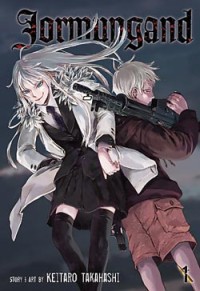
Vol. 1
(by Keitaro Takahashi, Viz Media, $12.99)
FROM THE BACK COVER:
"Jonah is a child soldier, born amidst the chaotic conflicts that rage across West Asia, his family lost to a war fueled by weapons supplied by the so-called Merchants of Death—international arms dealers. Despite Jonah's hatred of weapons and violence, he employs both extremely well in the service of high-flying arms dealer Koko Hekmatyar and her band of mercenaries. Their journey through the dark underbelly of the world's arms markets may lead only to damnation, but will Jonah one day make his way back to the light? Only one thing is certain: it's going to be a long, hard road out of hell...
Koko Hekmatyar, the head of H&C Logistic Incorporated, introduces new recruit Jonah to her team of troubleshooters, and it isn't long before they have some trouble to shoot. An Eastern European government official is holding up a shipment of aircraft parts that would shift the balance of power in the region. The trouble is, that shipment belongs to Koko, and she's not about to miss an opportunity to make a profit, even if it means two nations go to war."
EVIDENCE FOR:
What's really striking about Jormungand, in its early chapters, is how Koko so gleefully defies the stereotype of the military-themed seinen-action protagonist. She's not the cool, collected badass who marches into battle with twin submachineguns shooting magical homing bullets—instead, she's a ranting, raving master of panic always on the edge of meltdown ... which turns out to be much more entertaining. Meanwhile, the real badass of the story, Jonah, gets a couple of star moments but doesn't overwhelm the action—instead, it's Koko's sharp mind and negotiating ability that usually save the day. So even though they try to sell you on the gunplay, the car chases, and the hair-trigger politics, it's really the gamesmanship and psychological maneuvering that make this series what it is. With that foundation laid down, everything is just sweet, sweet frosting on the cake: frosting that consists of rich mechanical details, sharply angled layouts, and flashy motion-blur backgrounds that seem to make everything move at 1.5x speed. If you thought the characters were wild, just wait until you see their combat techniques. Whatever it takes to survive, right?
EVIDENCE AGAINST:
What is this, a lame-duck substitute for Black Lagoon? It may have the fancy explosions and geopolitical intrigue, but Jormungand falls short on a lot of the fundamentals. In a remarkable feat of bad storytelling, this volume manages to make less and less sense as the plot progresses—especially in the three-part "Pulsar" storyline that comprises the second half. You've got Koko and company selling their goods, a mercenary commander wishing to buy said goods, some other English guy doing I don't know what, and then at some point two of the other characters have a sword-and-knife fight for no real reason. Hey, it was a really cool fight, but the complete absence of logic ruins it. Even worse is when the series tries to do that whole "elite military secrets" thing by having everyone talk in jargon (Tom Clancy says hi) and jumping from scene to scene transitions without explanation. Of course, it doesn't help that the supporting characters are woefully underdeveloped. If you want to look at cool gunfights with no clue what's going on, this is the series for you.
FINAL VERDICT:
Just another gun-porn action series for macho guys to drool over ... not realizing, of course, that the quality isn't much better than a C.
NEGIMA!
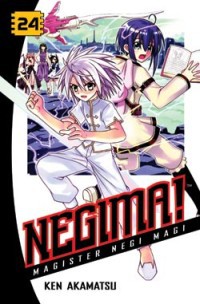
Vol. 24
(by Ken Akamatsu, Del Rey, $10.99)
FROM THE BACK COVER:
"The Festival of Ostia is the Magical World's most amazing event—and includes a major martial arts tournament in which Negi and his friends will be active participants! But a team of professional bounty hunters blocks Nodoka's way to the event. Can Negi save her, or will they all fall into the hunters' trap?"
EVIDENCE FOR:
With each passing volume of Negima!, the criticism of Ken Akamatsu as a fanboy-pandering, one-note hack becomes increasingly inaccurate. Just look at his rendition of Ostia and witness the breadth of Akamatsu's imagination: a city floating on clouds (with a wink and nod to Miyazaki), with ancient ruins and stark wastelands below, all drawn in intense detail—and accompanied by a world-encompassing, history-spanning back story. And that's to say nothing of the actual plot points covered in this volume, which plumb the very depths of love (Ako's oh-so-bittersweet infatuation with the fictional Nagi), hate (Negi comes face to face with his adversary and has an epic ... conversation over a cup of tea), and pure adventure (Negi shows off his newfound powers as he rescues Nodoka from a band of bounty hunters). Speaking of Negi's newfound powers, the fight scenes here are beyond spectacular: just imagine the wizardry and effects he pulled off at the end of the School Festival arc, then multiply it several times over, and cram that into bursts of just a few pages each. The result? Another stunning installment of what is quickly becoming one of the best shounen series right now.
EVIDENCE AGAINST:
Imagination? What imagination? The only thing Akamatsu's improved at is finding new places to steal from. It's not just the city-in-the-sky thing: almost every element of the Magical World is carefully lifted some other genre work, whether it be the sandworms accompanying the bounty hunters, or the traditional RPG party that Nodoka's traveling with, or the glowing dark magic emanating from Negi's forearm, or even the most pivotal plot point—the hidden truth about Asuna's childhood. So, it's not like Akamatsu's storytelling has gotten better; it's simply that this story arc has given him more room to throw in everything and the kitchen sink. That also seems to be his approach toward the cast of characters, which has become much more crowded now that everyone has showed up at Ostia. Look, I may have a bishoujographic memory, but even I have to draw the line at this story arc and say: too many girls. Meanwhile, others may be complaining about too many words—it's important to explain the particulars of the Magical World, yes, but why does it always end up turning into massive blocks of text?
FINAL VERDICT:
To steal from one is plagiarism; to steal from many ... is to come up with a really fun adventure story. The addictive, cross-crossing plotlines and ever more impressive artwork earn this volume a B.
SAMURAI HAREM: ASU NO YOICHI
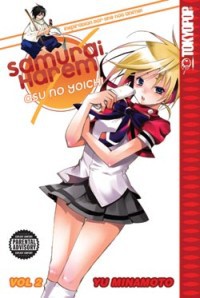
Vol. 2
(by Yu Minamoto, Tokyopop, $12.99)
FROM THE BACK COVER:
"As his training continues, two new girls come to town looking for Yoichi. The last remaining students of a dying ninja clan, Tsubasa and Angela have one goal: kill Yoichi in order to save their school! As the fight heats up and the clothes come off, will Yoichi be able to handle everything thrown at him?"
EVIDENCE FOR:
What's funnier than an anachronistic, sword-swinging, ye-olde-Japanese-speaking warrior? How about two anachronistic warriors! The arrival of Yoichi's would-be assassins ups the comedy ante, as newcomer Angela clearly thinks that everyone is trying to challenge her to battle. However, it's her meek companion Tsubasa who steals the show here, with her unexpected crush on reformed bully Washizu (gotta love how she keeps imagining him as a "prince" from some old-school shoujo romance) and the conflict between her desire for a normal life versus the duties of a ninja clan. Then, when the eldest Ikaruga sister starts softening towards Yoichi, even going so far as to train his manners on a "practice date," well ... it may come as a surprise, but this series has a lot of heart. Don't think it's gotten too wimpy, though—there's still some blistering fighting action to be had, and it's clear that the eye candy here extends beyond just cute Ninja Girls. A confident sense of line and great visual timing makes this an action fan's delight, full of high-flying kicks and split-second maneuvers.
EVIDENCE AGAINST:
Note to Yu Minamoto: stick to the swordfights and fisticuffs, because the harem aspect of this series just isn't working. Asu no Yoichi's attempts at fanservice are predictable at best, and embarrassing at worst—the conveniently angled pantyshots, the random acts of undressing, the highly improbable situations (Yoichi molests Angela in his sleep after she sneaks into his house? Really?). Nothing is quite as groan-inducing as the plot device in the second chapter, though, where we learn that one of our heroines becomes a ruthless killing machine when her clothes are stripped off! Yeah, that was cheesy two decades ago and it's even worse now. Even Minamoto's drawing style doesn't lend itself well to fanservice: the character designs are all on the short and squishy side, so trying to convince one's self that these young ladies are supposed to be curvy and attractive becomes a losing battle. And the storyline—what storyline? For the duration of the assassin arc, it never feels like Yoichi is in any danger, and the "let's all be friends" resolution is a total cop-out. Come on, this warrior deserves a real challenge.
FINAL VERDICT:
It may be cute and funny at times, but let's be realistic here—this is pure D+ material all the way through.
WAQWAQ
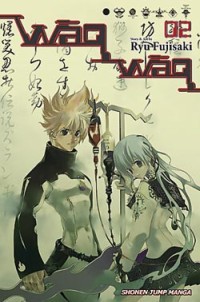
Vol. 2
(by Ryu Fujisaki, Viz Media, $9.99)
FROM THE BACK COVER:
"Living in constant fear of attack from machines, mankind depends on the cyborg corps known as the Guardians to keep them from harm as they await the arrival of the Kami, a godlike savior with mythical red blood who can grant Only One Wish to one person. Now, Shio, son of a Guardian, thinks he's found the Kami—and all of the Guardians are at war to get that wish!
The girl who could be the Kami is kidnapped by a trio of mysterious sages. To save her, Shio must join forces with a former opponent and battle through a slew of ever more powerful renegade Guardians!"
EVIDENCE FOR:
It's already Volume 2 of Waqwaq, but I'm still drooling over the visual creativity of this series as if it were the first time. There's no shortage of fascinating characters and impressive landscapes in this world, where post-apocalyptic futurism collides with ... just about everything else. Machines, cyborgs, and monsters; spiritualism, technology, and alternate dimensions; deserts, forests, and marshlands—all the elements of a great adventure are found right here, and they just keep getting better. The centerpiece of this volume—the battle between Shio and a 20-foot giant named Lord Drexel—proves that there are still plenty of ways to defeat a guy in the classic "fight increasingly powerful opponents until you come out on top" formula. Even peripheral characters and subplots are a triumph of artistic design, like the impeccably dressed trio who run the supercomputer named Spider's Thread, a distant battle between two other Guardians, and a water warrior who literally pops out of a lake. What's more, this grand adventure even comes with a sense of humor in the form of a wannabe ninja. And what could be more fun than that?
EVIDENCE AGAINST:
A lot of things could be more fun than Waqwaq, which looks really promising and unique but turns out to be just another story about (yawn) some teenage boy fighting to save the world. See, here's the problem: it IS full of all the elements of a great adventure, but when you're throwing everything in and not thinking about how it all fits together, or which direction to take, it just becomes this thematic mess—man versus machine? Last Hope of a dying world? Quest to reach a final destination? Which is it? And because Ryu Fujisaki has apparently jumped into this without thinking it through, he ends up taking the path of least resistance: just send lots of opponents at the hero while figuring out what to do with the actual plot. But even that plan fails, because the battle system is—embarrasingly enough—based on Pokémon, at least if we are to believe the wisdom that "plant beats earth, but fire beats plant, and water beats fire." Seriously, who comes up with an eye-popping, mind-bending post-apocalyptic universe and then rips off a kids' video game? Someone fix this, please.
FINAL VERDICT:
And even more seriously, who throws this much artistic effort into a painfully average fighting series? It's a C+ for Waqwaq, and that plus-sign is just for looking pretty.

KAIKISEN (RETURN TO THE SEA)

(by Satoshi Kon, Kodansha, ¥1200)
SUMMARY:
Yosuke and his family have maintained a shrine in the small coastal town of Amide for generations. However, the shrine is more than just a place of worship: it is also home to a closely guarded "mermaid's egg," which must be returned To the Sea every 60 years to ensure good fortune for the residents of Amide. When real estate developers set their sights on Amide as a potential resort town, Yosuke's father takes great interest in this moneymaking venture, and the family secret about the mermaid's egg is revealed in hopes of generating tourism. But Yosuke and his grandfather, realizing the importance of staying true to the mermaid legend, decide to fight against the forces of modern commerce encroaching upon the town.
EVIDENCE FOR:
It's Satoshi Kon, for goodness sakes. Do I really need to explain Satoshi Kon? Fine then, here goes. Kaikisen may not be on a level with Kon's animated films, but it's still cinematic in many ways: the gradual arc of the story building up to a thrilling climax, the strong-willed characters whose conflicts and motivations keep the story moving, and of course, the gorgeous eye candy peppered throughout the volume. Still, it's Kon's ability to blur the lines between reality and fantasy that really make his work stand out—the slice-of-life realism is strong in this story, yet there's just enough ancient folklore to keep readers guessing about the authenticity of the mermaid's egg. As the plot develops, so does the sense of wonder, and the climactic chase scene proves that Kon can do blockbuster action just as convincingly as all the quiet, ordinary moments. Meanwhile, the visuals also capture the seaside atmosphere perfectly: idyllic sketches of the town, awe-inspiring views of the ocean, and a mind-blowing natural phenomenon at the end that will remind you to never, ever break promises with mermaids. Not bad for a guy who was still years away from Perfect Blue.
EVIDENCE AGAINST:
Well, that's the problem right there: he was still years away from Perfect Blue. Although this single-volume effort hits a lot of points that will make critics say "artistic" and "imaginative" and "accomplished," it still bears the flaws of a young but unpolished creator. The idealistic theme of Nature Good, Technology Bad is presented in a hackneyed manner, a Disney morning cartoon where all the real estate guys are evil sneering villains and the residents of the town are innocent and noble souls. Then when you get to the one morally ambigious character—Yosuke's dad—his motivation for supporting the bad guys turns out to be this poorly developed back story about Yosuke's deceased mother. The mechanics of the plot also get sloppy at times, with scene transitions and shifts of viewpoint that sometimes pop up in odd, confusing places. As for artistic weaknesses, well, you'll probably forget what the characters look like as soon as you turn the last page.
FINAL VERDICT:
Like I said: it's Satoshi Kon. It may be the raw work of a genius-in-training, but the fact that it's still the output of genius makes it a must-read.

What's the gateway manga series that will get non-fans hooked? For our guest reviewer M. Gilbert, it's a one-word answer: Monster. And below is the reason why!
Keep those reviews coming, folks—tell the world how you plan to convert the uninitiated!
MONSTER
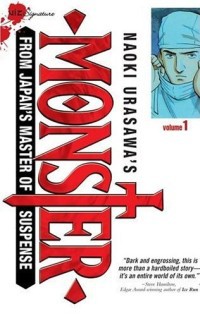
(by Naoki Urasawa, Viz Media, $9.99 ea.)
I honestly would choose to show the non-believer Monster. This is one series that made me take a whole different outlook on manga and anime, and it set my standards pretty high for rating things on quality. The reason why I would recommend Monster is mainly because I've seen it work on people before. A main example would be my older brother who stereotypically thought that I was weird because I liked anime and such. However, when I introduced him to this series (animation and manga both), he fell in love with it. Now, he even sits down and reads a variety of series himself.
Also, for those people who think the wonderful world of anime/manga is childish, this series features a mature story with more than a pinch of realism. It starts off in a slower fashion, but does so that the reader can understand what type of characters and setting everything is in. In other words, it gradually sucks in the reader to where they sympathize with the main character.
It follows the life of a genius surgeon named Kenzou Tenma. He's a man with the skill that makes him the best for the hospital he works for in Germany. His life seems to be perfect, supported by the fact he's engaged to the hospital's director's daughter. However, when he begins to realize the horrible facts of hospital politics, the hardest decision in his life is thrust upon him. Moreover, will the life of the boy saved today have a drastic outcome in the future?
I would also like to add that the mystery lovers out there, who aren't exactly fans of manga, would most likely have a field day with this series. It's an intricate case of serial murders weaved together with a psychological touch. The story features complex characters with very deep perceptions and personalities. Even the most minor of characters play some sort of role in forming the main character Tenma.
Of course, there are plenty of other Manga ONE could suggest. Other titles I would suggest would be ones such as 20th Century Boys, Solanin, Mushishi, etc. It all really depends on the person you're showing it to; what their likes and dislikes are. However, I would say the one to introduce to a non-fan adult would definitely be this series Monster.
Is there a hidden gem of manga you'd like to reveal to the world? Is there a piece of garbage that deserves to be bashed in public? Or is there a title that didn't get a fair grade here, and you want to set the record straight?
Now's YOUR chance to be the reviewer! Write a review of about 300-400 words (a little more or less is fine) and include:
- your name.
- Title of manga (and volume no., if applicable)
- Author/Artist
- Publisher
- Briefly describe the story, then explain why this manga is great, terrible, or in between. Be objective, but also be entertaining.
Then send it in to rtoreaders (at) gmail (dot) com (plain text format preferred). One review will be selected out of all the submissions and will be published in the next column. All types of manga and manga-inspired comickry are accepted, from past and present, from Japan and beyond—what matters is that it's the Reader's Choice! NOTE: Submissions may be edited for formatting and grammar.
discuss this in the forum (23 posts) |